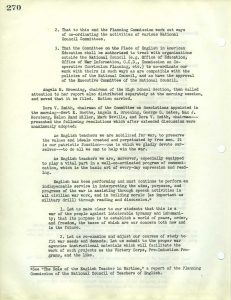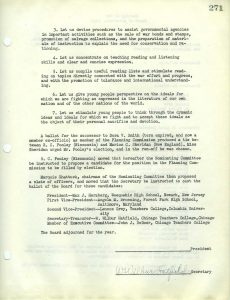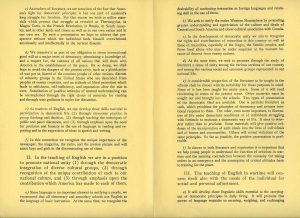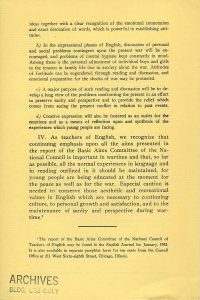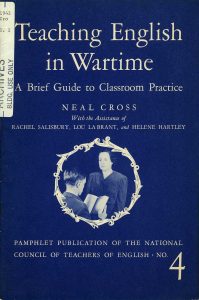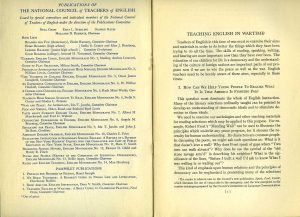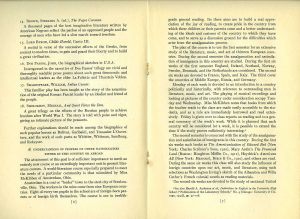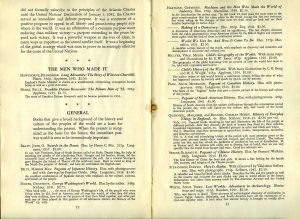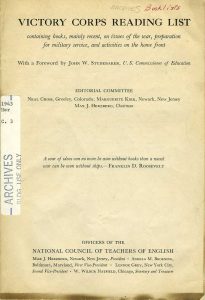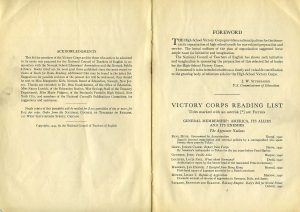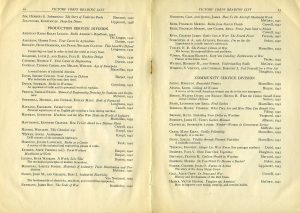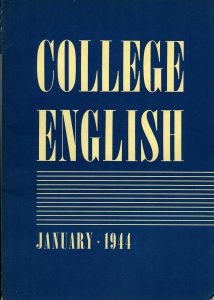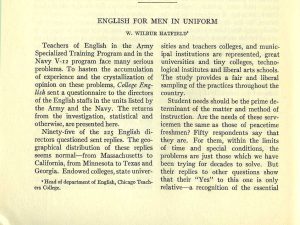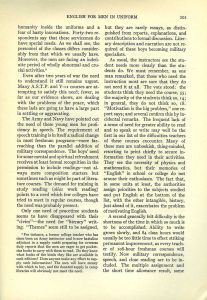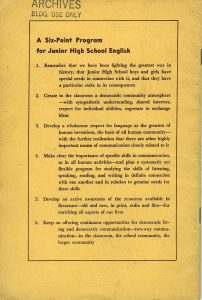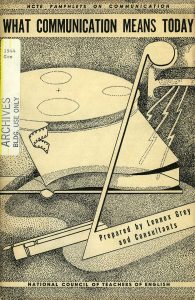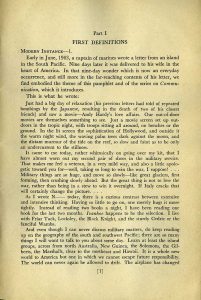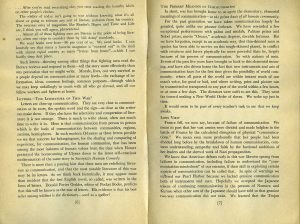“We need to make…changes, and individually we will perform special wartime duties; but the initial message from outstanding college teachers is that we must do the job for which we are trained: help others to realize the power that emanates from great literature to live humanely in the midst of conflict.”
From College Journal, “English in Wartime” (1942)
World War II had an immediate, tangible effect on the U.S. educational system. With both teachers and students being among millions of Americans drafted, there was a diminished college population. But the war was also a driving force for many intangible changes. In particular, educators needed to change their curriculum to better reflect the needs and challenges in this new environment.
For NCTE, this meant thinking about the discipline of English and its role in supporting the war effort. According to J.N. Hook in A Long Way Together: A Personal View of NCTE’s First Sixty-Seven Years, “the Council reacted immediately to the state of war by creating a Planning Commission” (1979, p. 133). It tackled the basic, yet weighty questions posed by the war: “Can the teaching of English in American…schools remain unchanged by our entrance into World War II? And should it? If not, how should it be changed?” (p. 133).
The planning Commission determined that while the basics of English should remain the same, certain aspects of the subject had more significance during wartime. After all, English was a valuable discipline to the war effort’s communication needs. Marion Sheridan, NCTE Executive Board member, pointed out that English played a vital role in democracy:
“A democracy depends upon the use of words, upon the ability to understand and to discuss questions of freedom, liberty, labor; upon the ability to trace the course of thought and to detect specious argument…. Literature is a storehouse of the experiences of mankind…. Its peace and serenity may give balance and a sense of normalcy, and fortitude, when total war dominates the situation.” (qtd. in Hook, p. 135)
To help English teachers fulfill the discipline’s role during this dire time, NCTE published a series of pamphlets to guide them in thinking about how the war affected their curriculum. In addition, the journals College English and the English Journal regularly featured articles and letters about the special challenges teachers faced. To learn more about NCTE’s role in World War II, take a look at the featured topics below:
- Minutes of Board of Directors Meeting, November 1942
- The Role of the English Teacher in Wartime
- Teaching English in Wartime: A Brief Guide to Classroom Practice
- The Four Freedoms and the Atlantic Charter
- Victory Corps Reading List
- The English Journal
- College English
- Junior High School English
- What Communication Means Today
November 1942 Board of Directors Meeting
In November 1942, NCTE held its annual board meeting, its first since the United States declared war on the Axis powers. The minutes record a series of resolutions affirming the Council’s devotion to supporting the war effort. The resolutions consisted of seven main points, the first of which emphasized the grave threat the country was facing and what was at stake: “Let us make clear to our students that this is a war of the people against intolerable tyranny and inhumanity; that its purpose is to establish a world of peace, order, and freedom, the bases of which are our concern both now and in the future.” Learn more: 15/70/001
Item: Minutes of Board of Directors Meeting (1942)
The Role of the English Teacher in Wartime
The Role of the English Teacher in Wartime was the result of the Planning Commission’s work on determining if the English curriculum should be changed because of the war. They determined that while the basics should remain the same, “especial caution is needed to conserve those aesthetic and recreational values in English which are necessary to continuing culture, to personal growth and satisfaction, and to the maintenance of sanity and perspective during wartime.” The Council also stressed the importance of maintaining all tenets of democracy, including “international good will,” to avoid the danger of intolerance and hatred. Learn more: 15/73/803
Item: Copy of The Role of the English Teacher in Wartime (1942)
Teaching English in Wartime
To further guide teachers, NCTE published Teaching English in Wartime: A Brief Guide to Classroom Practice. Authored by Neal Cross, member of the Planning Commission, this pamphlet addressed the question of how teachers can adapt their curriculum to the war. The Council again emphasized the importance of international relations and understanding foreign cultures. One of the most prominent concerns, however, was how to instill a devotion to democracy in students. Learn more: 15/71/809
Item: Copy of Teaching English in Wartime: A Brief Guide to Classroom Practice (1942)
The Four Freedoms and the Atlantic Charter
To stress the importance of English during World War II, NCTE published numerous pamphlets informing teachers and students on how the war affects English education. The pamphlet, The Four Freedoms and the Atlantic Charter: A Reading List for Young People, focused on what readings would help junior high students understand the problems and issues brought up by Franklin Roosevelt’s Four Freedoms speech and by the Atlantic Charter. NCTE hoped that through these recommended books, students would understand the significance of the war and the challenges that await after the war. Learn more: 15/71/824
Item: Copy of The Four Freedoms and the Atlantic Charter (1943)
Victory Corps Reading List
Another pamphlet the Council published was the Victory Corps Reading List, which provided book recommendations for members of the High-School Victory Corps. The reading list was divided into categories related to different aspects of the war, including America’s allies and enemies, food production, and community service. The U.S. Commissioner of Education, J.W. Studebaker, praised NCTE for its “initiative and imagination in sponsoring” the list. Learn more: 15/71/824
Item: Copy of Victory Corps Reading List (1943)
The English Journal
Throughout the war, The English Journal published articles on how the change from peacetime to wartime affected English education. The article entitled “The Council Meets in Wartime” in the February 1943 issue discussed the annual NCTE meeting where along with usual business, the Council also had to make critical decisions regarding English’s place in the war. Not only did the Council pass measures recommended by the Resolutions Committee to help with the war effort, but the English Journal published letters from teachers illustrating how the war affected students and their learning needs. Learn more: 15/71/801
Item: Copy of English Journal (1943)
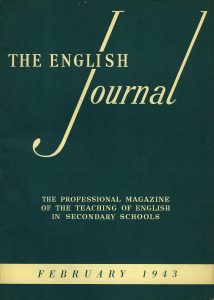
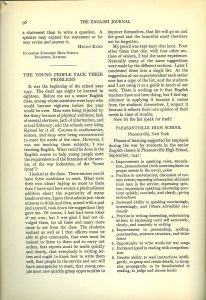
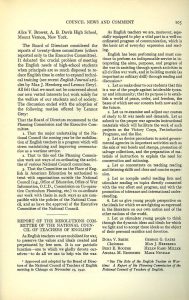
College English
College English was especially focused on the war. At the college level, students and their teachers were eligible to be drafted. In the February 1942 issue, the article “English in Wartime: A Symposium by College Teachers” discussed the specific challenges and changes the war would bring to the English curriculum and what must stay the same. In an article in the January 1944 edition, W. Wilbur Hatfield examined the learning needs of soldiers, drawing upon the results from an NCTE survey sent to the directors of English staff in the Army and Navy. Learn more: 15/71/802
Item: Copy of College English (1944)
English in Junior High School
College and high school students were not the only ones whose needs the Council addressed during this time. Junior High School English, prepared by the Committee on Junior High English in Time of War, focused on younger students and their role in the war. They created a “six-point program” for teachers, the first point declaring “Remember we have been fighting the greatest war in history, that Junior boys and girls have special needs in connection with it, and that they have a special stake in its consequences.” The Council was not solely focused on the war, however, acknowledging that educating students about life during peace was just as important for this generation so accustomed to war. Learn more: 15/73/803
Item: Copy of Junior High School English (1944)
What Communication Means Today
“This will be known as the war of letters,” said Donald Porter Geddes, quoted in What Communication Means Today by Lennox Grey. This book served to educate readers on the importance of communication during World War II. The author shared numerous anecdotes of soldiers writing back home and of communication errors that caused defeats in the battlefield. In addition, Grey quoted a soldier, stating that “Almost all of these fighting men are literate to the point of being literary…. We want books over here — 90 percent of us. We need books.” The author pointed out that communication also facilitates propaganda. As with how the Council acknowledged that the English curriculum must change to adapt to war, this book defined the changing nature of communication during World War II. Learn more: 15/71/824
Item: Copy of What Communication Means Today (1944)
